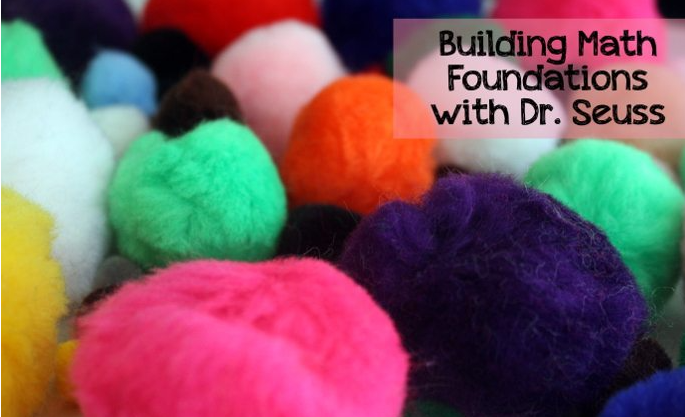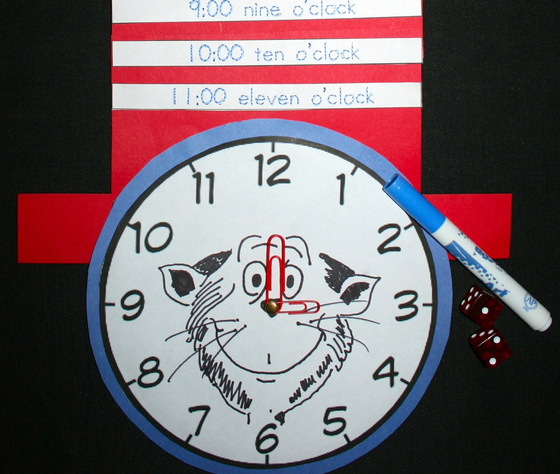Enhance your classes by imbedding the teaching of important content, in unique and exciting activities. The following Dr. Seuss math activities and games focus on practicing math skills in a progressive yet simple manner. Let’s delve right in and start building stronger math skills!
1. Skip Counting Puzzle

Practice memorizing various counting patterns with the help of this nifty puzzle hat! Challenge learners by timing them to see who can order the numbers, in a pattern of your choosing, the fastest!
Learn More: Creative Family Fun
2. Pom Pom Math Foundations

Build math foundations with the help of friendly Horton the elephant and a few colorful pom poms. Enjoy an assortment of activities ranging from counting and sorting to graph building and more!
Learn More: Parenting Chaos
3. Measure With Feet

Practice grasping the concept of measurement by tracing your students’ feet and having them measure and record their findings. To up the anti even more, ask older learners to record their answers in a graph or chart!
Learn More: Inspiration Laboratories
4. Lorax Addition

Reap the rewards of this adaptable game! Whilst this Lorax-inspired counting activity practices addition, there’s nothing stopping teachers from adapting its use to suit other skills.
Learn More: Jdaniel 4s Mom
5. Fishbowl Sums

Get familiar with number bonds and practice developing quick math with the help of an assortment of wonderful worksheets!
Learn More: Planes and Balloons
6. Ten Apples Up On Top

This math game requires the use of milk caps or other reasonably sized lids. Students roll a dice and follow the que- adding or subtracting accordingly.
Learn More: Mama Papa Bubba
7. Cat In The Hat Measuring Tools

Acquaint your learners with the concept of measurement using weird and wacky measurement tools. P.S. This is a great skill for practicing multiplication and division!
Learn More: Fairytales and Fiction
8. Tell Time With A Cat In The Hat Clock

Practice ordering time using this fun dice-roll and sequence game. Whatever the number on the dice is, students should glue the corresponding time in the appropriate place on their striped hat.
Learn More: Teach with Me
9. Seuss’ Story Sums
Don’t you just love story sums! These nifty problems help students think in an analytical way and are fantastic activities to keep on hand for extra remedial work or quick finishers during class time.
Learn More: Heerens Happenings2
10. Green Eggs And Ham Number Lip Cards

These are great flash-card math problems for young learners who need practice with number recognition.
Learn More: Teachers Pay Teachers
11. Terrific 2D Shape Juggler

Introduce 2D shapes to your learners with the help of these awesome activity sheets. Students not only learn the different shapes and their properties, but they get great practice writing too!
Learn More: Classroom Freebies
12. Get Acquainted With Numbers 1 and 2
Solidify number concepts with these math worksheets aimed at number recognition and memorization.
Learn More: Kindergarten Teacher Resources
13. Mystery Picture Numbered Coloring Chart
Reveal the picture hidden within the numbers by following the coloring directions displayed at the bottom of the activity sheet.
Learn More: TPT
14. One Fish Two Fish Counting Bowl
Enjoy solving fish math questions with the help of a fishbowl counting bowl. This activity is perfect as a simple craft task as well.
Learn More: Mrs. Thompson’s Treasures
15. Grinch Addition & Subtraction Board Game

This Grinch-themed board turns into a fun math game when students are required to solve math problems before progressing forward on the grid.
Learn More: Pinterest
16. Dot-to-dot Horton
Build number knowledge with this connect-the-dot activity. Horton the elephant, from Horton Hears A Who, is waiting on the other side for you to color in!
Learn More: Connect The Dots 101
17. Tell Time With Dr. Seuss
Discover analog and digital time with Dr. Seuss. Play games and solve math problems using varied worksheets that your learners will love!
Learn More: Classroom Freebies
18. Pattern Maker
Color or paint patterns and learn about repetition and relationships. Older students can learn about how to analyze patterns in order to make predictions and or generalizations.
Learn More: Creative Pre-school Resources
19. Even And Odd

Discover the difference between odd and even using this fun roll-the-dice activity.
Learn More: Google Drive
20. Roll And Cover

Gain good practice in addition by rolling three dice and adding their sum together. Cover the sum before another player gets a turn.
Learn More: Pinterest
21. Dr. Seuss Counters

Practice counting, pattern making, and grouping with these colorful Dr. Seuss character counters.
Learn More: Rainbow Resource
22. Symmetry Shaper

Fill in the missing lines by trying to match your drawing, in the blank space, to the lines printed on the other half of the page. This math game challenge is superb for classes that focus on the teaching of symmetry.
Learn More: Pin Img
23. Count with Yertle The Turtle
Practice counting with these excellent eggbox turtle creations. Students are invited to pile up their turtles and count as they go!
Learn More: Inspiration Laboratories
Math activities help children develop an understanding of the world around them- learning to understand shapes and connections and solve problems. Whilst math activities are important whole class tasks, independent math practice should be encouraged outside of class hours to further help learners progress in their math journeys.
Frequently Asked Questions
What is the importance of math in early childhood learning?
Math activities help young learners develop critical reasoning and problem-solving skills as well as increase visual and spatial awareness. Teaching math in a fun and manageable way allows students to build a strong mathematical foundation for later learning.
From what age should I teach math?
Children should be exposed to basic number concepts such as number recognition, fluency, and counting from toddler age.
Why do some children struggle with math?
Math often requires abstract thought and reasoning. Memory is also put to the test when children have to solve multiple elements of a problem before revisiting and combining their answers to finally locate the end result.